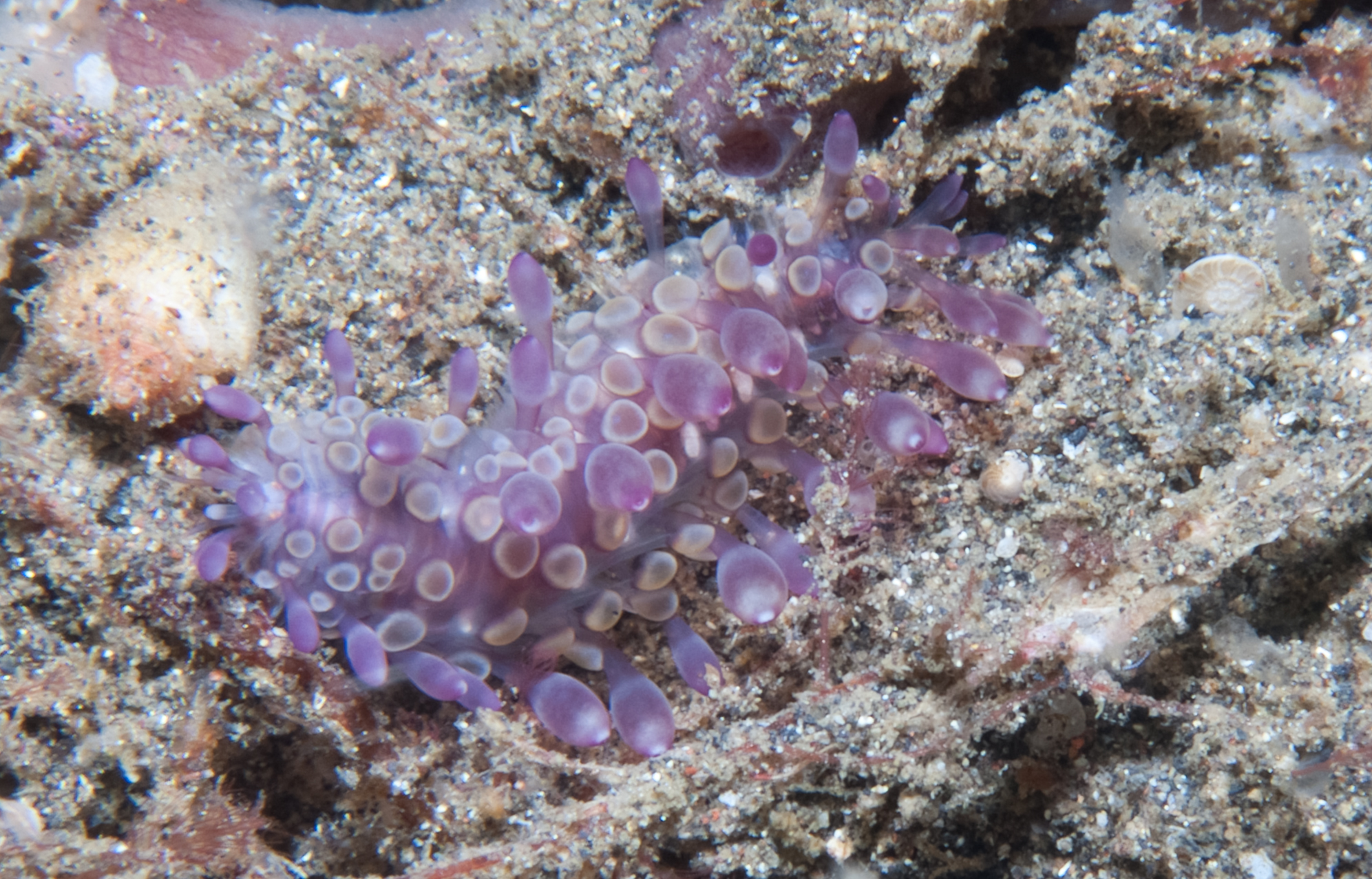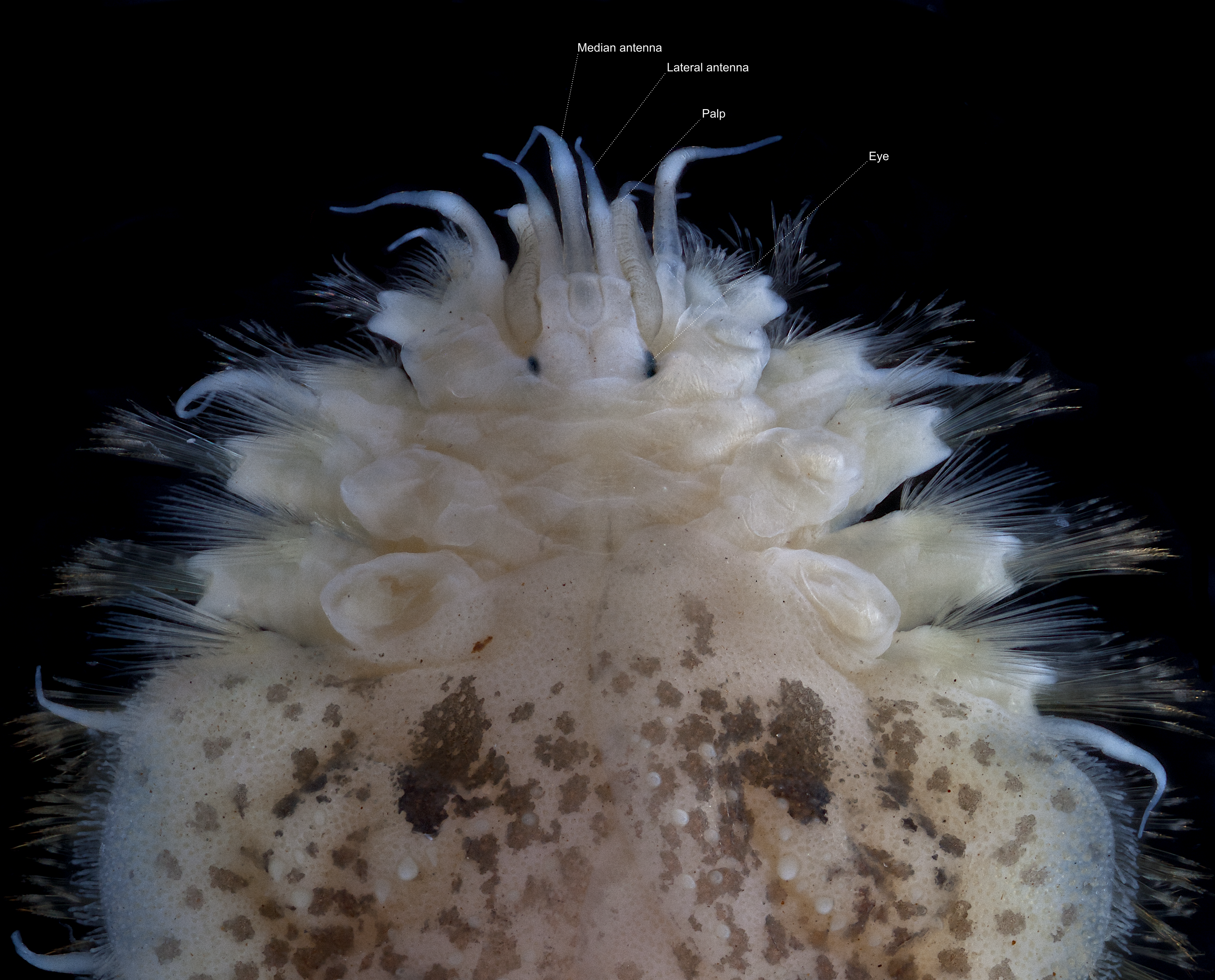|
Australaugeneria
''Australaugeneria'' is a genus of marine annelids in the family Polynoidae (scale worms). The genus includes 4 species which are commensal on octocorals. Description Elytra 15 pairs, 36–40 segments. Lateral antennae inserted ventrally (beneath prostomium and median antenna). Neuropodia deeply incised vertically, so that the neurochaetae emerge from a prominent division between the pre-chaetal (= acicular) lobe and the post-chaetal lobe. Notochaetae A chaeta or cheta (from Greek χαίτη “crest, mane, flowing hair"; plural: chaetae) is a chitinous bristle or seta found in annelid worms, (although the term is also frequently used to describe similar structures in other invertebrates such ... present, hooked neurochaetae in anterior-most segments, bidentate neurochaetae absent (summarised from detailed diagnosis of Ravara & Cunha, 2016).Ravara, Ascensão; Cunha, Marina R. (2016). Two new species of scale worms (Polychaeta: Aphroditiformia) from deep-sea habitats ... [...More Info...] [...Related Items...] OR: [Wikipedia] [Google] [Baidu] |
Australaugeneria Michaelseni
''Australaugeneria michaelseni'' is a scale worm known from northern Australia and Papua New Guinea from depths of 30m or less. Description Number of segments 36; elytra 15 pairs. Depigmented. Lateral antennae inserted ventrally (beneath prostomium and median antenna). Notochaetae about as thick as neurochaetae A chaeta or cheta (from Greek χαίτη “crest, mane, flowing hair"; plural: chaetae) is a chitinous bristle or seta found in annelid worms, (although the term is also frequently used to describe similar structures in other invertebrates such .... Bidentate neurochaetae absent. Commensalism ''Australaugeneria michaelseni'' is commensal. Its host taxa are alcyonacean corals. References {{Taxonbar, from=Q1976652 Phyllodocida ... [...More Info...] [...Related Items...] OR: [Wikipedia] [Google] [Baidu] |
Australaugeneria Rutilans
''Australaugeneria rutilans'' is a scale worm known from northern Australia, south-east Asia and the Persian Gulf, from depths of 28m or less. Description Number of segments 40; elytra 15 pairs. Clear, white no pigments other than black eyes. Lateral antennae inserted ventrally (beneath prostomium and median antenna). Notochaetae about as thick as neurochaetae A chaeta or cheta (from Greek χαίτη “crest, mane, flowing hair"; plural: chaetae) is a chitinous bristle or seta found in annelid worms, (although the term is also frequently used to describe similar structures in other invertebrates such .... Bidentate neurochaetae absent. Commensalism ''Australaugeneria rutilans'' is commensal. Its host taxa are alcyonacean corals. References {{Taxonbar, from=Q2391902 Phyllodocida ... [...More Info...] [...Related Items...] OR: [Wikipedia] [Google] [Baidu] |
Australaugeneria Iberica
''Australaugeneria iberica'' is a scale worm known from the Gulf of Cadiz in the north-east Atlantic Ocean from a depth of 2230m. Taxonomic status ''Australaugeneria iberica'', known from a depth of 2230 m, is the only bathyal species in the genus; the remaining 3 species are known from depths of 30 m or less. Description Elytra 15 pairs (presumably; all 3 type specimens incomplete). Unpigmented. Lateral antennae inserted ventrally (beneath prostomium and median antenna). Notochaetae thinner than neurochaetae. Commensalism ''A. iberica'' is commensal. Its host taxa are alcyonacean corals such as Acanella ''Acanella'' is a genus of deep sea bamboo coral of the family Isididae. Acanella are mainly studied and found in Hawaii, they are able to survive in high-flow sites and are preyed upon by nudibranch mollusks. It has a high fecundity and small ... or a similar genera. References {{Taxonbar, from=Q41162823 Phyllodocida Animals described in 2016 ... [...More Info...] [...Related Items...] OR: [Wikipedia] [Google] [Baidu] |
Australaugeneria Pottsi
''Australaugeneria pottsi'' is a scale worm known from northern Australia from depths of 21m or less. Description Number of segments 38; elytra 15 pairs. Depigmented. Lateral antennae inserted ventrally (beneath prostomium and median antenna). Notochaetae distinctly thicker than neurochaetae A chaeta or cheta (from Greek χαίτη “crest, mane, flowing hair"; plural: chaetae) is a chitinous bristle or seta found in annelid worms, (although the term is also frequently used to describe similar structures in other invertebrates such ..., or thinner than neurochaetae. Bidentate neurochaetae absent. Commensalism ''A. pottsi'' is commensal. Its host taxa are alcyonacean corals. References {{Taxonbar, from=Q2657015 Phyllodocida ... [...More Info...] [...Related Items...] OR: [Wikipedia] [Google] [Baidu] |
Polynoidae
Polynoidae is a family of marine Polychaete worms known as "scale worms" due to the scale-like elytra on the dorsal surface. Almost 900 species are currently recognised belonging to 9 subfamilies and 167 genera. They are active hunters, but generally dwell in protected environments such as under stones. The group is widely distributed from shallow intertidal waters to hadal trenches. They are the most diverse group of polychaetes in terms of genus number and second most diverse in terms of species number which is almost 8% of all segmented worm species. Description Most Polynoidae species are short and flattened, but can reach as much as 20 cm in length and 10 cm width in ''Eulagisca gigantea'' and ''Eulagisca uschakovi''. Individuals are usually covered almost entirely by elytra, which can be shed and regenerated in many species. The elytra of some species are faintly bioluminescent, and leave glowing traces around the mouthparts of their predators, making those preda ... [...More Info...] [...Related Items...] OR: [Wikipedia] [Google] [Baidu] |
Annelid
The annelids (Annelida , from Latin ', "little ring"), also known as the segmented worms, are a large phylum, with over 22,000 extant species including ragworms, earthworms, and leeches. The species exist in and have adapted to various ecologies – some in marine environments as distinct as tidal zones and hydrothermal vents, others in fresh water, and yet others in moist terrestrial environments. The Annelids are bilaterally symmetrical, triploblastic, coelomate, invertebrate organisms. They also have parapodia for locomotion. Most textbooks still use the traditional division into polychaetes (almost all marine), oligochaetes (which include earthworms) and leech-like species. Cladistic research since 1997 has radically changed this scheme, viewing leeches as a sub-group of oligochaetes and oligochaetes as a sub-group of polychaetes. In addition, the Pogonophora, Echiura and Sipuncula, previously regarded as separate phyla, are now regarded as sub-groups of polycha ... [...More Info...] [...Related Items...] OR: [Wikipedia] [Google] [Baidu] |
Commensalism
Commensalism is a long-term biological interaction (symbiosis) in which members of one species gain benefits while those of the other species neither benefit nor are harmed. This is in contrast with mutualism, in which both organisms benefit from each other; amensalism, where one is harmed while the other is unaffected; parasitism, where one is harmed and the other benefits, and parasitoidism, which is similar to parasitism but the parasitoid has a free-living state and instead of just harming its host, it eventually ends up killing it. The commensal (the species that benefits from the association) may obtain nutrients, shelter, support, or locomotion from the host species, which is substantially unaffected. The commensal relation is often between a larger host and a smaller commensal; the host organism is unmodified, whereas the commensal species may show great structural adaptation consistent with its habits, as in the remoras that ride attached to sharks and other fishes. R ... [...More Info...] [...Related Items...] OR: [Wikipedia] [Google] [Baidu] |
Octocorallia
Octocorallia (also known as Alcyonaria) is a class of Anthozoa comprising around 3,000 species of water-based organisms formed of colonial polyps with 8-fold symmetry. It includes the blue coral, soft corals, sea pens, and gorgonians (sea fans and sea whips) within three orders: Alcyonacea, Helioporacea, and Pennatulacea. These organisms have an internal skeleton secreted by mesoglea and polyps with eight tentacles and eight mesentaries. As with all Cnidarians these organisms have a complex life cycle including a motile phase when they are considered plankton and later characteristic sessile phase. Octocorals have existed at least since the Ordovician period, as shown by Maurits Lindström's findings in the 1970s, however recent work has shown a possible Cambrian origin. Biology Octocorals resemble the stony corals in general appearance and in the size of their polyps, but lack the distinctive stony skeleton. Also unlike the stony corals, each polyp has only eight tentacle ... [...More Info...] [...Related Items...] OR: [Wikipedia] [Google] [Baidu] |
Elytron (Annelida)
In annelids, elytra (; from Greek Greek may refer to: Greece Anything of, from, or related to Greece, a country in Southern Europe: *Greeks, an ethnic group. *Greek language, a branch of the Indo-European language family. **Proto-Greek language, the assumed last common ancestor ... ἔλυτρον "sheath, cover"; singular: elytron ) are shield-like scales that are attached dorsally, one pair on each of a number of alternating segments and entirely or partly cover the dorsum. Elytra are modified dorsal cirri, and their number, size, location, and ornamentation are important taxonomic characters. The basal part of the elytra is known as the elytrophore; if (as is often the case) elytra are lost their presence is indicated by the elytrophore which is still present and visible. Annelids possessing elytra are also known as "scale worms". Possession of elytra is characteristic of the annelid suborder Aphroditiformia. Gallery File:Eunoe leiotentaculata lower res.jpg, A '' Eunoe ... [...More Info...] [...Related Items...] OR: [Wikipedia] [Google] [Baidu] |
Prostomium
The prostomium (From Ancient Greek, meaning "before the mouth"; plural: prostomia; sometimes also called the "acron") is the cephalized first body segment in an annelid worm's body at the anterior end. It is in front of (but does not include) the mouth, being usually a small shelf- or lip-like extension over the dorsal side of the mouth. The prostomium together with the peristomium, which includes the mouth and pharynx, make up the annelid head. Description The prostomium is part of the head and holds at least part of the brain and often bears sensory structures such as the eyes, antennae and palps. It may function like a kind of overlip when the animal is feeding. The prostomium bears many important taxonomic characters and its shape and composition are important for annelid systematics. In addition to the eyes, antennae and palps, the prostomium can possess appendages such as tentacles or cirri. Moreover, some polychaete prostomia have a posterior extension or ridge with ... [...More Info...] [...Related Items...] OR: [Wikipedia] [Google] [Baidu] |
Parapodia
In invertebrates, the term parapodium ( Gr. ''para'', beyond or beside + ''podia'', feet; plural: parapodia) refers to lateral outgrowths or protrusions from the body. Parapodia are predominantly found in annelids, where they are paired, unjointed lateral outgrowths that bear the chaetae. In several groups of sea snails and sea slugs, 'parapodium' refers to lateral fleshy protrusions. __TOC__ Annelid parapodia Most species of polychaete annelids have paired, fleshy parapodia which are segmentally arranged along the body axis. Parapodia vary greatly in size and form, reflecting a variety of functions, such as gas exchange, anchorage, protection and locomotion. General description Parapodia in polychaetes can be uniramous (consisting of one lobe or ramus) but are usually biramous (two lobes or rami). In the latter case, the dorsal lobes are called notopodia and the ventral lobes neuropodia. Both neuropodia and notopodia may possess a bundle of chaetae (neurochaetae and notochaet ... [...More Info...] [...Related Items...] OR: [Wikipedia] [Google] [Baidu] |
Chaeta
A chaeta or cheta (from Greek χαίτη “crest, mane, flowing hair"; plural: chaetae) is a chitinous bristle or seta found in annelid worms, (although the term is also frequently used to describe similar structures in other invertebrates such as arthropods). Polychaete annelids, ('polychaeta' literally meaning "many bristles") are named for their chaetae. In Polychaeta, chaetae are found as bundles on the parapodia, paired appendages on the side of the body. The chaetae are epidermal extracellular structures, and clearly visible in most polychaetes. They are probably the best studied structures in these animals. Use in taxonomy and identification The ultrastructure of chaetae is fundamentally similar for all taxa but there is vast diversity in chaetal morphology. Moreover, chaetae bear precise characters for determination of species and taxonomic assessment. The shape, absolute and relative size, number, position, ornamentation and type are important taxonomic characters a ... [...More Info...] [...Related Items...] OR: [Wikipedia] [Google] [Baidu] |





